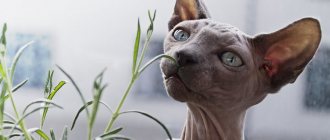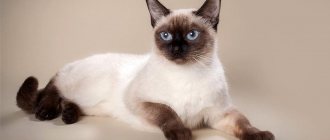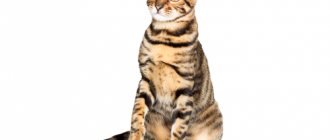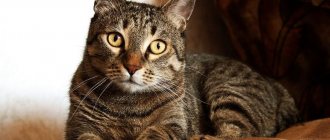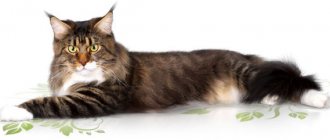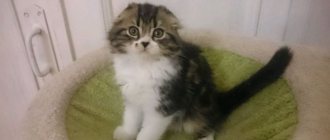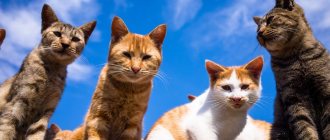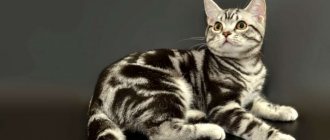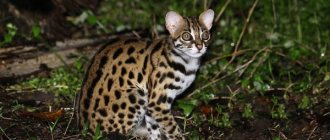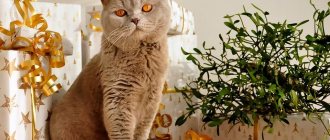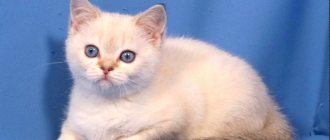Key facts
“Petriki”, which is what the owners call their pets, is a young breed that appeared on the territory of Russia in the city of St. Petersburg. These are very graceful representatives of the cat family who prefer to receive love from their owner in the form of gentle touches and strokes. The purring and demanding voice of the Peterbald can be heard at any time of the day.
Their slightly sticky skin has a higher temperature than their hairy counterparts. Thanks to this, they can perfectly warm their beloved owner during the cold season.
Increased thermoregulation led to a literally brutal appetite in these elegant individuals. Due to their irrepressible energy, figurines, vases and flower pots are in danger of being destroyed.
“ Due to the abundance of protein secreted by saliva, Peterbalds cannot be considered hypoallergenic creatures.
Specifics of the skin
The main specificity in the description of the Peterbald Sphynx breed is that skin folds are formed throughout the Peterbald's body.
When the animal moves, they move smoothly throughout the body. The greatest concentration of folds is observed on the face, neck, and paws.
On the muzzle the folds are concentrated on the forehead, diverging interestingly in the area of the brow ridges.The tail is in the form of a whip. Thinning gradually from a wide base and rounding at the end. Does not form kinks.
History of the origin of the Peterbald breed
The hairless St. Petersburg cat was the result of crossing two breeds - the Don Sphynx and the Oriental. Attempts to create new representatives occurred in 1994. Felinologist from St. Petersburg Olga Mironova, as a result of crossing two different breeds, received four kittens: Sissy, Mandarin, Muscat and Nocturne from Murino. It was this hybrid offspring that became the ancestors of modern Peterbalds.
The international community liked the breed so much that just 2 years later, international organizations began to issue permission for its breeding. The last one to receive recognition from the WCF was in 2003.
Although the cats have been standardized, a reference representative has not yet been obtained. The breed continues to develop. It is curious that the main goal of breeders is not to obtain a hairless pet. For them, the external characteristics of the animal are important: oriental appearance with features of Orientals and Siamese.
Breeding work
Unfortunately, there is still no general program for the development of the breed - despite the clear positions of the standard, the breeders have not reached a consensus, and they have their own reasons for this. But in general, the breed is actively developing towards a variety of colors and extreme types of animals. For this purpose and to expand the gene pool of Peterbalds, until recently the blood of oriental cats was used in breeding work: Siamese, Orientals, Balinese. Now the breed is already closed and matings are allowed only within it.
Peculiarities of breeding
Due to the high percentage of eastern blood, Peterbalds tend to have multiple births. This facilitates selection work and allows you to more quickly navigate what qualities a particular parent pair is capable of passing on to their offspring.
From mating to birth
The parental pair is selected not so much by the degree of “undress” of the producers, but by the successful combination of their genotypes and phenotypes. It is very important that the breeder planning the mating is aware of the hereditary health of several generations of cats behind the future parents, and also does not allow animals with obvious anatomical defects to be bred.
For breeding work, animals are selected that are already fully formed physically - no earlier than two years of age. The bride and groom must be absolutely healthy, promptly vaccinated and treated against all types of parasites. Mating traditionally takes place in the cat's territory, where he feels much more confident, and is repeated twice or thrice with an interval of one day.
“Newlyweds” usually have very touching relationships
The expectant mother usually carries and gives birth to heirs without any problems, but during pregnancy she requires increased attention: more affection, tenderness, care and respect - do not forget about this; for a Peterbald, such a person’s attitude is especially important.
Peterbald kittens
The maternal instinct of Peterbalds is superbly developed - a cat of this breed is ready to feed not only her own, but also other people's kittens. They constantly lick their cubs and generally pay them a lot of attention, patiently spending a long time raising the younger generation.
Peterbald cats are caring and attentive mothers
Other cats will definitely take part in the educational process, if there are any in the house, even the father cat will not remain indifferent either. The entire pride will take care of the kittens, which is actually very rare in the cat family.
Breeders are well aware of an interesting pattern: the less hair on a newborn Peterbald, the sooner it will open its eyes. Absolutely “rubber” babies are usually born with their eyes open, and you need to vigilantly protect them from infections so that conjunctivitis does not develop. This breed type is difficult to develop in the first weeks of life, and the mortality rate in hairless kittens is quite high. However, by the age of one and a half months, all health problems usually remain a thing of the past.
In some breeding lines, hairless animals are sometimes born sterile.
Kittens with soft fur are more likely to be completely hairless by adulthood.
Straight-haired kittens and kittens with a hard “brush” usually do not undress by adulthood. Only those individuals whose fur is soft from birth shed their fur.
Sterilization issues
If you have adopted a St. Petersburg Sphynx, but do not plan to seriously engage in breeding work, then it is definitely better to sterilize the animal in a timely manner. The hormonal balance in Peterbalds is quite unstable, and the lack of demand for animals in breeding is fraught with serious diseases.
Males may develop hormonal disorders, which externally manifest themselves as dermatological problems and provoke malfunctions in almost all internal organs. In nulliparous females in some breeding lines, frequent mastitis is observed.
In addition, sterilization may become an indispensable condition for the sale of a pet-class kitten that is unpromising for breeding, and this is a fair requirement. Sterilization or castration is optimally carried out for Peterbalds aged from one to one and a half years. The operation can only be trusted to experienced specialists in a veterinary clinic; The responsible recovery period should also take place under their control.
Video:
What does a Peterbald look like?
Representatives of this breed are real top models of the cat world. The appearance of the pet leaves no one indifferent. Just look at their dreamy look and bat ears!
Muzzle
The Peterbald's head is wedge-shaped, tapering as it approaches the nose. The long muzzle of the St. Petersburg Sphynx is distinguished by a slightly convex profile and a flat forehead.
The ears are large, widening at the base. They seem to be an extension of the cat's face.
Almond-shaped eyes are slanted, which looks very interesting. According to breed standards, the iris can be green or bright blue. Moreover, the last color is typical for the point color.
St. Petersburg sphinxes do not have mustaches - or they are presented in the form of broken, crimped hairs.
Body type
Peterbald boasts a graceful physique, which does not exclude strong muscles that cover the entire body of the animal. The silhouette line is very elegant. The neck has a graceful curve and elongated shape. The hips are slightly wider than the chest.
The front and hind limbs of representatives of this breed have an ideal straight shape. They are thin and quite long. Paws are oval. Fingers are flexible.
The whip-like tail has a pointed tip. This part of the body is thin and long.
Size and weight
According to standards, the weight of the St. Petersburg Sphynx can be in the range from 3 to 5 kg. These are average sizes, so you shouldn’t expect the kitten to grow into a cat that is too large or too graceful.
Varieties according to undercoat length
The Peterbald is characterized by soft skin that fits loosely around the entire body. Folds form on the skull. The St. Petersburg sphinxes inherited the “bald” gene from their Don brothers. However, some individuals may have sparse and very short hair.
Based on the length of the undercoat, Peterbalds are divided into:
- Hairless, whose skin feels like rubber to the touch. Discharge forms on your pet's skin. They create a thin brown coating on the surface of the body.
- Flock - absolutely beardless and eyebrowless individuals with very short fur. Its length should be no more than 2 mm and be the same throughout the entire body.
- Velor, the peculiarity of which is the presence of short or semi-long wool. As the kittens grow older, it may disappear. Then cute furry socks appear on the paws.
- Brush-pointed - individuals with a hairless or flocked body. The muzzle, paws and tail are covered with stiffer hairs.
- Brushevyh - the pet's body is covered with crimped hair. Animals may be partially or completely pubescent. Brush representatives become bald in the back and neck areas as adults.
- Straight-haired variettes are animals that have not inherited the hairless gene. They have the same coat and whiskers as regular shorthair cats. These kittens are cheaper.
In addition to the listed species, there are also subspecies. For example, flock point, velor point and others. In addition, it is very difficult to figure out what type of kitten will be in adulthood.
Colors
In accordance with the standards, Peterbalds can be color-point and oriental colors. Individuals of the first type have the following colors: cream-point, torti-, lilac-, seal-, tabby-, chocolate-, seal-, blue-.
Oriental type can be: cream, tabby, red, tortoiseshell, chocolate, bicolor, black or blue.
Disqualifying faults
Because it is a new breed, standards continue to change. However, the already identified main disadvantages of the St. Petersburg Sphinx are:
- too fragile physique;
- forelimbs of a curved shape;
- absence or a small number of folds of skin on the skull.
Different coat options, partial or full, as well as hairless type are acceptable, as they can correspond to flock, velor or other subtypes.
Differences from other sphinxes
If you look at photos of Peterbalds, you will hardly be able to find differences between cats from St. Petersburg and their Don counterparts. In fact, St. Petersburg sphinxes are much more miniature creatures. Their body is somewhat more refined and graceful. Don Sphynxes can weigh up to 7 kg, while Peterbalds only gain 3-5 kg. The grace of the Petrikovs is similar to the elegance of the Orientals.
Flock
This variety lacks mustaches and eyebrows, but they have a small coat of fur that does not exceed 2 mm.
The Peterbald with wool is also very popular; caring for it is a little easier, because almost the entire body is covered with a thin layer of hair.
Personality of Peterbald cats
Cats from St. Petersburg are extremely open and sociable. Mustachioed friends have a good-natured character, so they are not prone to feline manifestations of revenge.
However, excessive affection can become burdensome. It is vital for Peterbalds to sit on the lap of their beloved owner and faithfully look into the person’s eyes. It is curious that pets quickly become attached to people, so changing owners is not a big problem for them.
“ Despite their sociability and good nature, mustaches can turn into real bald demons. This happens in those families where little time was devoted to high-contact animals.
Peterbalds are very curious. Thanks to their flexible, almost “monkey” fingers, they can crawl into any crevice, open packaging they are interested in, or even pick up the zipper of a handbag.
Main characteristics
The main distinguishing feature of the Peterbald breed is its hairless, compact, somewhat rectangular body with a wide chest.
The Peterbald's head tapers towards the nose. The forehead is flat - forms a straight line in profile.
There is no transition from the muzzle to the skull.
The eyes are large and almond-shaped. The nose is rounded, does not protrude forward and is not set back.
The wedge shape can be seen throughout the entire shape of the skull and the contour of the ears. The narrowest part - the nose begins to widen, moving into the cheekbones, and then into the outer edge of the ears.
The ears themselves are very large and widely spaced on the skull. This is what forms the wedge shape of the head. The tips of the ears are strongly rounded, which, together with the rounded eyes, gives the cat a soft appearance.
The toes are elongated, which further creates an image of grace and elegance.
Raising a Peterbald
Highly intelligent animals are very trainable. Representatives of the St. Petersburg breed are happy to carry out the commands of their beloved owner. And if you present everything in a playful way, then learning will be even better.
The most basic commands that pets execute can be “Come to me!”, “You can’t!” The most persistent owners ensure that cats bring them balls or other toys.
Before starting training, it is important to consider the mood of your pet. After all, no amount of treats or affection will make him follow orders if he doesn’t want to do it.
“Socialization and habituation should begin immediately after the animal arrives at home. Kittens need to be accustomed to extraneous noises and sharp sounds. A hairdryer, vacuum cleaner and other household appliances should be perceived calmly by children.
Peterbalds are excellent travelers. They like to accompany their owner on long trips. True, for a very small animal, long journeys will be a real test.
St. Petersburg Sphynxes get used to the litter box without any problems. Some pets are able to learn to use the toilet. The owner just needs to buy a special pad for training, gradually raising it to the level of the toilet. Experienced cat breeders advise not to rush and accustom them to using the human toilet in stages.
Possible problems
Despite the lack of hair, the main problem of sphinxes is saliva and allergies to it in humans, especially in children. Peterbalds lick themselves often and a lot, the drying saliva evaporates and can cause allergic reactions and diseases, including bronchial asthma. Exfoliating skin particles are also a strong allergen.
Peterbalds require careful care and proper nutrition, which entails serious financial expenses. Animals are designed to live exclusively within four walls; any contact with the outside environment is undesirable.
It is not recommended to have St. Petersburg Sphynxes for those who are almost never at home - animals cannot stand loneliness, suffer and become depressed, even to the point of death.
Peterbald breed health
Possible diseases
Since the Peterbald is a fairly new breed, it is too early to talk about the presence of hereditary diseases in animals. However, over time, information about genetic defects may become available.
Breeders are already talking about a possible predisposition of St. Petersburg Sphynx cats to pulmonary diseases. Heredity may also explain other physiological defects. So, tortoiseshell, cream or blue cats have gum hyperplasia.
Otherwise, the graceful pets are quite healthy. Of course, they are susceptible to seasonal colds, skin diseases and eye problems. But all this can be solved with care and regular visits to the veterinarian.
The main thing that the Peterbald owner should pay attention to is changes in the quality of the fatty lubricant. If its color, smell or consistency becomes unusual, then some problems occur with the animal’s body. It is better to contact a veterinarian who will conduct a full examination of the eared patient and prescribe treatment if necessary.
Reproductive health and breeding
Mating is best done in the male's territory. In this case, the cat will be calmer, and the process may end successfully. Only fully mature individuals should be bred. Females are ready to reproduce healthy offspring at the age of 1-1.5 years. An earlier pregnancy can have a negative impact on the physiological and psychological state of the mother cat.
On average, 4 to 5 kittens are born in a litter. If the cat is not intended for breeding (pet class), then it is better to resort to castration.
Diseases
Peterbalds live about 13-15 years. But there are a number of factors that negatively affect their health and life expectancy. They should be remembered.
Firstly, these are direct rays of the sun. Burns form instantly on the Peterbald's delicate skin, so take care of it.
Secondly, Peterbald skin is prone to acne and various types of irritation. The means at hand will help you cope with it, for example, a fresh decoction of chamomile. It is not uncommon for Peterbalds to injure themselves while playing. If you notice a fresh scratch, immediately treat it with hydrogen peroxide.
Peterbalds have a genetic predisposition to certain diseases.
- Gingival hyperplasia: occurs frequently and is often combined with the development of purulent conjunctivitis. Quickly becomes chronic. A complete cure is impossible, but improvement is possible.
- Congenital underdevelopment of the thymus gland or kitten “falling asleep” syndrome (caused by a gene mutation). Often causes the death of the entire litter.
- Vasculitis of the skin: inflammation of the walls of blood vessels. There are several clinical manifestations. Develops due to stress or infection. With timely treatment, complete recovery is possible.
- Curvature of the caudal spine. Other anomalies are almost always present (weakness of the sphincter, dwarfism, shortening of the lower jaw).
- Inversion of the eyelids: in this case, the edge of the eyelid or eyelashes touch the eyeball. The only way to cope with the disease is through surgery, otherwise the cat will develop conjunctivitis and keratitis.
- Microphthalmos: abnormal development of the eyes. This may be blindness, decreased visual acuity, cataracts, congenital keratitis, orbital tumors, cyst formation, and the like.
- Carp bite: the lower jaw is too short. Cats adapt to their condition, but they are not allowed to be bred.
Expert opinion
Dusheba Vera Ivanovna
In 2010, she graduated from the Moscow State Academy of Veterinary Medicine named after K.I. Scriabin with honors, specializing in veterinary medicine. I regularly attend veterinary conferences, congresses, and webinars.
You cannot “mate” two completely naked animals. Unfortunately, it has already been proven that kittens are almost always born with serious pathologies.
Features of feeding and diet
Natural nutrition
Graceful individuals are real gluttons, ready to eat anything. They happily eat chips, buns, and sweets that an inattentive owner or his family members left unattended. Because of this, the animal's digestive system is constantly under threat.
Cats are practically omnivores, so feeding them natural food is not difficult. The main task of the owner of the St. Petersburg Sphynx is to monitor the balance of his pet’s menu.
The basis of the animal’s diet should be protein, which gets into the bowl in the form of lean beef, chicken or fish fillet, and offal. In addition, boiled and chopped vegetables and cereals should be added to food. Oatmeal, rice, and buckwheat are best suited for feeding your pet.
Peterbald should not be given:
- tubular bones;
- fatty meats, especially lard;
- raw meat and offal;
- fish with a lot of bones;
- sweets;
- smoked meats and pickles;
- baking.
The number of feedings also needs to be controlled. Kittens up to 1 year old can be given food 3-5 times. Since animals at this age are overly active, they quickly burn through calories. But cats older than 1 year should eat no more than 2 times a day, otherwise they cannot avoid obesity and deterioration of their health.
Ready-made feed
Dry or wet industrial food is also suitable for the diet of St. Petersburg individuals. The main thing is to choose only high quality products for the animal: super-premium or holistic.
The animal must be provided with all the vitamins and minerals necessary to maintain a healthy and beautiful appearance. Cheap food is not suitable for the diet of St. Petersburg cats - they can cause digestive disorders and have a bad effect on the skin.
It is necessary to provide Peterbald with constant access to clean drinking water. Moreover, it should be filtered or bottled - but not from the tap.
Temperament of the St. Petersburg Sphynx
For those people who are thinking about purchasing a Neva Sphynx, it would be useful to understand the features of this breed:
- Experts often call this animal a “cat-dog”, since its habits are more reminiscent of a dog’s - they follow their owner with their “tail”, are able to learn the simplest commands, are smart and amenable to training.
- They are loving towards all family members and do not tolerate loneliness well.
- They are affectionate, capable of waiting for the owner all day, sitting at the door and joyfully rushing towards him. They know their name well and respond.
- Talkative too much. If you love a calm, measured life, then it is unlikely to be possible with the St. Petersburg Sphynx. The cat almost always “talks”, expressing all his feelings and emotions.
- Since the Peterbald cannot be left alone at all, you will have to find him a playmate, and he will get along with absolutely any pet.
- They are very playful all their lives and are happy to join children in noisy fun.
- Smart and cunning. They easily learn to open everything - bags, drawers, doors to the room, and even the refrigerator.
- They are unusually voracious, which is due to their physiological characteristics.
- Clean, excellent hunters.
When choosing this pet, you need to remember that you won’t be bored with it and balance your habits and inclinations with the cat’s temperament.
Care and maintenance
Bathing and drying
Caring for the St. Petersburg Sphynx depends on the length of the undercoat. For straight-haired and brushed Peterbalds, the maintenance is somewhat different from how hairless pets are cared for.
Copious discharge appears on the skin of bald individuals. They form a sticky coating that protects and protects the skin from minor injuries and negative environmental influences. Therefore, you should not try to wash off the secretion of the sebaceous glands from your pet’s body.
Washing too often dries out the skin and can lead to flaking. Of course, a Peterbald needs to be bathed more often than a regular cat. But in case of slight contamination, you can simply wipe the dirty area with a clean cloth moistened with oil for caring for baby skin. When choosing shampoos, you should choose Ph-neutral ones - or even better, purchase a special product at a pet store.
Due to excessive work of the sebaceous glands, acne and pimples form near the tail. But such a skin nuisance is only possible in case of insufficient care. Excess must be removed at least once a week using special cleansing lotions or wipes. Subcutaneous wen should be removed - but this can only be done by a veterinarian in a clinic setting.
Cleaning teeth, eyes and ears
These parts of the St. Petersburg Sphynx's body require special care. So, a lot of secretion is formed in the animal’s ears. However, this does not mean that they constantly need to be cleaned with napkins or cotton swabs. Excess secretions should be removed no more than once a week, using lotion from a veterinary pharmacy for the care procedure.
The same product should be used to remove the sebaceous plaque that forms between the folds of the skin and between the claws. The resulting secretion can accumulate and interfere with the animal's movements.
The eyes of a hairless individual are not protected by eyelashes. Therefore, moisture in the form of tears forms on them more often than ordinary cats. Hairless pets with insufficient care may develop a thick secretion with a jelly-like consistency. This nuisance must be removed daily: it is advisable to do this in the morning with a clean cloth or napkin.
The need to wear clothes
Due to the scarcity of fur or its complete absence, Peterbalds are quite frozen creatures. The most comfortable temperature for them starts from +23°C.
A regular bedding or bed will not suit them. The best habitat for pets is a closed house with a comfortable rug inside. It must be installed on an elevated surface to provide protection from drafts.
“ For a comfortable existence, Peterbalds also need clothing. It must be put on immediately as soon as the temperature in the house drops below +22°C. Clothing should be made of soft fabrics that will not harm the animal's skin.
Before important exhibitions, it is advisable to refrain from wearing new clothes for a while to avoid chafing. In any case, you can choose knitted clothes or a suit for the animal, the seams of which are made outward.
Reviews
My family and I are the happy owners of a wonderful cat of the St. Petersburg Sphynx (or Peterbald) breed. We bought her about 9 years ago at a cat show at the age of 4 months. Ours is naked velor (flock). When I was a little girl, I didn’t even have a mustache, but now I have a few :). I have always wanted such a breed, I was especially attracted by the character and intelligence of cats, they are affectionate, smart, affectionate and love small children. That's how it turned out. This is the most tender animal in the world. You can’t imagine how much she loves us all. If someone is not at home for several hours in a row, when he meets you, he rejoices, caresses you endlessly, and follows you on your heels. When a child was born in the family, they were afraid that he might scratch or jump on the little one, so at first they kept the bedroom where the child slept closed at night. She, the poor thing, was crying under the door, my heart was breaking, but the child comes first, so what. Then they slowly began to let her in, and she never even scratched him, although he tore her as he wanted. She endured everything stoically if we didn’t intervene quickly. We, adults, could be bitten and scratched in play, but not little ones. When my husband and I went on vacation, she stayed with my mother and child in the apartment, she was very bored, ate, drank and slept, did not approach my mother to caress her, it was obvious that she was sad. When we arrived, everything returned to normal :). If you decide to get a Sphynx, be sure to take care of him, that is, for him, all these hugs and strokes are as important as food and water, seriously. Without them, the animal becomes sad and may get sick.
Moso
https://spasibovsem.ru/responses/samaya-laskovaya-koshka.html
A couple of years ago, my husband gave me a Peterbald cat. My joy knew no bounds, a small white creature with huge ears and huge blue eyes. On the very first night, priorities were set, the husband was kicked out of bed for 4 days, but after he started communicating with her he was accepted back, now the three of us sleep together) Peterbalds are a magical breed. Our girl is smart, very talkative, bright, playful, and sociable. She loves it when guests come to us, she immediately brings toys). Very patient in dealing with children, she will endure all the squeezing and manifestations of boundless love from the kids. Great breed for a family!!!
encore
https://irecommend.ru/content/lyubimyi-detenysh-foto-koshki
Firstly, of the sphinxes, the St. Petersburg sphinx is the most beautiful, graceful, a godsend for photographers. Very sociable and talkative, for those who love quiet animals - this can be considered a disadvantage. Therefore, this breed is for children, because it is very playful and for lonely people who lack communication. The most important thing is education - as you teach and show prohibitions, that’s how they will be. If you give in at least once, then you won’t be able to wean him off, for example, to climb on a table. My sphinxes do not climb, even if there is raw meat there. From a hygienic point of view, this is the most advantageous breed, because you can wash yourself as often as you do. They sweat when it's hot, the skin is oily, but this is not a problem - wipe it with a damp napkin and that's it. In terms of character and intelligence, they are between a dog and a cat - you can calmly teach them to carry out basic commands. These breeds practically do not mark; my adult cat does not know how to mark. The cat goes to the toilet, there are no problems with the trays, it all depends on how you train it. The skin is very hot, it is good to treat radiculitis and not only - they find the sore spots themselves and sit down.
AllahK
https://irecommend.ru/content/peterburgskii-sfinks-zamechatelnaya-poroda
Tips for choosing a kitten
Purchasing a pet with such an unusual appearance should be especially thoughtful. If the future owner has never owned hairless animals before, then it is better to get to know them better first. Not everyone will like sticky skin with a characteristic odor. But if this does not bother you, then you can look for a proven nursery.
Of course, you should only buy an animal from reliable breeders with an excellent reputation. Otherwise, you can purchase a false Peterbald dog suffering from unpleasant genetic diseases.
“ It should be taken into account that kittens of some colors, for example, color point, are born white. Their future color can be seen on the nose, ears, paws and tail only after a week.
Most St. Petersburg cats acquire a “finished” appearance only by the age of 1.5-2 years. Therefore, it is important to look at the exterior of the baby’s parents before purchasing it.
Description
Peterbald is a cat from a picture of a fashion publication. The pet looks elegant and aristocratic. His appearance reminds him of catwalk models. The breed standards are defined as follows:
- Narrow long head, extended forward. There is a smooth bend where the head passes into the neck.
- Proud profile, straight long nose.
- Like many Sphynxes, the Peterbald has large ears. The placement of the breed's ears is English set. Their tips are spread in different directions, and a sheet of paper can be held on the head.
- It is rare to have whiskers, but if they are present, the whiskers are curled.
- Large eyes are almond-shaped. They are slightly slanted. The color of the iris is blue, cyan, green, yellow. Kittens open their eyes 3-4 days after birth, quite early.
- The size of adults is average. The Peterbald has an elongated, slender, tube-shaped body. That is, if you look at the animal from above, the width of the hips and shoulders is the same.
How much does a Peterbald cat cost?
Because of their novelty and uniqueness, representatives of the breed are included in the TOP 20 most expensive cats in the world. The cost of a kitten starts from 20,000 rubles. For this amount an animal with simple colors is sold without the right to further mating.
A champion cat with an excellent pedigree and exotic color is sold in the range from 50,000 to 100,000 rubles. According to advertisements, you can buy a baby for 8,000-10,000 rubles. However, such an animal is unlikely to meet the standards of a graceful cat.
Do you like the article? 0
Breeding
You can purchase a Peterbald kitten in nurseries or by advertisement from private individuals. The price of these beautiful animals depends on the pedigree or the popularity of the nursery where you want to purchase the animal. Basically, the price for this cat is from 4,000 rubles. The appearance of the kitten depends on the appearance of its parents. For example, if you cross an Oriental Shorthair with a hairless Peterbald cat, the kittens will only be brush and flock. If both parents are Peterbalds, their children will be mostly flocked and hairless.
